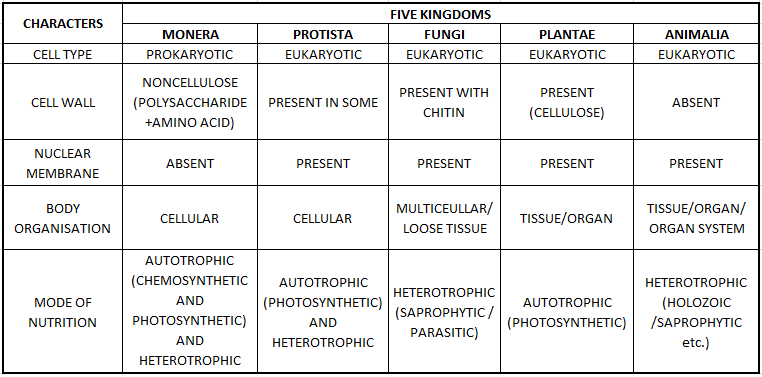NCERT 11TH STANDARD BIOLOGY – BIOLOGICAL CLASSIFICATION – INTRODUCTION
Since the dawn of civilisation, there have been many attempts to classify living organisms. It was done instinctively not using criteria that were scientific but borne out of a need to use organisms for our own use – for food, shelter and clothing. Aristotle was the earliest to attempt a more scientific basis for classification. He used simple morphological characters to classify plants into trees, shrubs and herbs. He also divided animals into two groups, those which had red blood and those that did not.
In Linnaeus’ time a Two Kingdom system of classification with Plantae and Animalia kingdoms was developed that included all plants and animals respectively. This system did not distinguish between the eukaryotes and prokaryotes, unicellular and multicellular organisms and photosynthetic (green algae) and non-photosynthetic (fungi) organisms. Classification of organisms into plants and animals was easily done and was easy to understand, but, a large number of organisms did not fall into either category. Hence the two kingdom classification used for a long time was found inadequate. Besides, gross morphology a need was also felt for including other characteristics like cell structure, nature of wall, mode of nutrition, habitat, methods of reproduction, evolutionary relationships, etc. Classification systems for the living organisms have hence, undergone several changes over the time.Though plant and animal kingdoms have been a constant under all different systems, the understanding of what groups/organisms be included under these kingdoms have been changing; the number and nature of other kingdoms have also been understood differently by different scientists over the time.
R.H. Whittaker (1969) proposed a Five Kingdom Classification. The kingdoms defined by him were named Monera, Protista, Fungi, Plantae
and Animalia. The main criteria for classification used by him include cell structure, body organisation, mode of nutrition, reproduction and
phylogenetic relationships. The three-domain system has also been proposed that divides the Kingdom Monera into two domains, leaving the remaining eukaryotic kingdoms in the third domain and thereby a six kingdom classification. You will learn about this system in detail at higher classes.
Let us look at this five kingdom classification to understand the issues and considerations that influenced the classification system. Earlier classification systems included bacteria, blue green algae, fungi, mosses, ferns, gymnosperms and the angiosperms under ‘Plants’. The character that unified this whole kingdom was that all the organisms included had a cell wall in their cells. This placed together groups which widely differed in other characteristics. It brought together the prokaryotic bacteria and the blue green algae ( cyanobacteria) with other groups which were eukaryotic.
It also grouped together the unicellular organisms and the multicellular ones, say, for example, Chlamydomonas and Spirogyra were placed together under algae. The classification did not differentiate between the heterotrophic group – fungi, and the autotrophic green plants, though they also showed a characteristic difference in their walls composition – the fungi had chitin in their walls while the green plants had a cellulosic cell wall. When such characteristics were considered, the fungi were placed in a separate kingdom – Kingdom Fungi. All prokaryotic organisms were grouped together under Kingdom Monera and the unicellular eukaryotic organisms were placed in Kingdom Protista. Kingdom Protista has brought together Chlamydomonas, Chlorella (earlier placed in Algae within Plants and both having cell walls) with Paramoecium and Amoeba (which were earlier placed in the animal kingdom which lack cell wall). It has put together organisms which, in earlier classifications, were placed in different kingdoms. This happened because the criteria for classification changed. This kind of changes will take place in future too depending on the improvement in our understanding of characteristics and evolutionary relationships. Over time, an attempt has been made to evolve a classification system which reflects not only the morphological, physiological and reproductive similarities, but is also phylogenetic, i.e., is based on evolutionary relationships.

